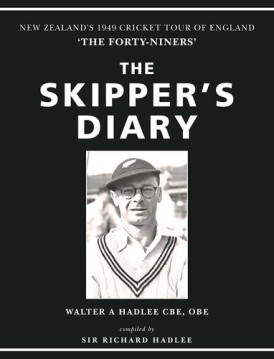The Skipper’s Diary
Archie Mac |Published: 2017
Pages: 473
Author: Hadlee, RJ (Compiler)
Publisher: The Cricket Publishing Company
Rating: 4.5 stars

There have been a number of quality cricketing diaries over the years, however they have tended to be in relation to county cricket, with Peter Roebuck’s It Never Rains and Jonathan Agnew’s 8 Days A Week being a couple of the best.
Test cricket has not been served as well in the diary* department, until now that is. A Skipper’s Diary covers the 1949 tour of England by the New Zealand team. The diary was kept by the captain and patriarch of NZ cricket Walter Hadlee.
Perhaps because the diary was never meant for public consumption, Hadlee is seemingly candid in his observations on every subject. This makes for some compelling reading, especially with the benefit of hindsight, as we meet some legendary figures.
Hadlee is critical of the polarising Sir Donald Bradman, being unimpressed with some perceived slights. Hadlee later records that Norman Yardley, the opposing captain to Bradman’s all conquering ‘greats of 48’, was also unimpressed with The Don.
Another ominous mention by Hadlee was that King George VI was not well when they met him on the tour. A quick check of Wiki informs that the King died of lung cancer just less than three years later. In fact I spent an inordinate amount of time looking up people and places mentioned in A Skipper’s Diary, which materially added to the enjoyment of the journey. There were so many famous people and topics of interest covered in the diary that it’s impossible to include them all in this review but one that was a real shock concerns legendary broadcaster John Arlott, who was unsure if the BBC were going to employ him as a cricket commentator.
Hadlee was an accountant by profession and this may explain why he keeps meticulous records of expenditure throughout his diary and was extremely organised. He sets goals for his players to reach both individually and as a team and appears to leave no stone unturned. This extends to a number of lectures on the outward trip. The entry for 11th March 1949 includes Hadlee providing a talk to his team on the laws of the game. He managed to reach page 18 of the law book.
Another talk is given on health with the nutritional information provided very similar to that espoused today. The big difference between 1949 and 2017 was the information on tobacco with Hadlee recording that cigarettes were only bad if you had 60 to 70 a day. Pipes – Hadlee was a devotee of the pipe – are apparently not harmful. It was a shock to see just how much tobacco was consumed by the team. It appeared as though every player chain smoked throughout the tour.
In the end the main focus of the book was the 1949 tour of England. This was a great success for NZ cricket as they managed to draw the four Test series nil all. They also only lost one match during the tour. The main reason for the nil results in the Test matches was that NZ were only offered three day Tests. It was a surprise to learn that, due to the success of the tour, the Kiwis were offered an extra day in the fourth Test, which they turned down. The logic for the decision was not explained.
The success of the NZ team was based on the batting with a couple of all time greats in the side in Bert Sutcliffe and Martin Donnelly. The bowling was not so strong and, with the short games and one of the finest English summers in decades, bowling was tough.
We meet all the players and see their triumphs and failures as both cricketers and men as seen through the eyes of Walter Hadlee. The captain was a tough taskmaster. The two he seems to have had issues with the most were the outgoing Tom Burtt and ‘Fen’ Cresswell. Burtt was criticised for asking for too many freebies and discounts on tour and ‘Fen’ for being too social. Despite his firmness with his players, comments by his team in later years confirm that Hadlee was loved and respected by the entire squad. Especially for his meticulous plans and care for his men.
So involved in the tour was the captain, he eventually had some sort of breakdown and fainted during a match. Hadlee was then forced to miss a couple of matches and take some much needed R&R. You can almost feel his frustration as the tour marches on while he relaxes at the team hotel or with friends.
This is a thoroughly enjoyable read and is one of those books that you instantly miss as soon as you close it for the last time. The production values are first class and it comes with an informative DVD that almost deserves a review of its own. Don’t miss this one and if you have some extra cash consider purchasing the limited signed edition by Walter’s five sons including the legendary Sir Richard.
*I have been reliably informed that there is a diary by Australian batsman Brian Booth that is well worth a read. I have ordered my copy and will review it in the near future.







Leave a comment